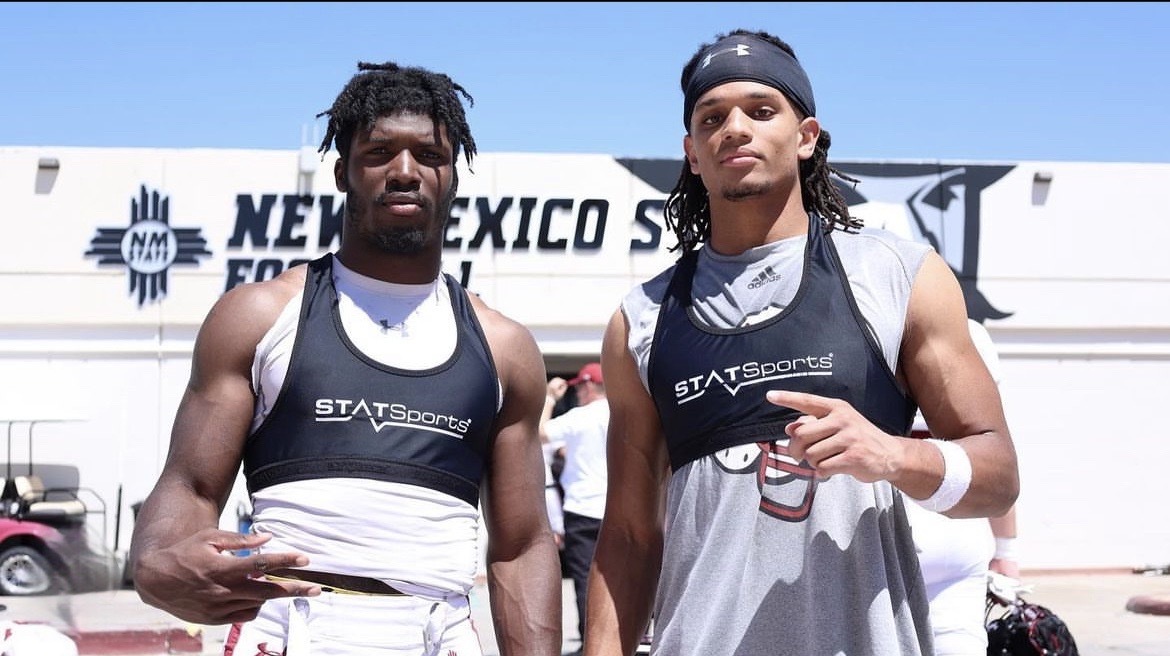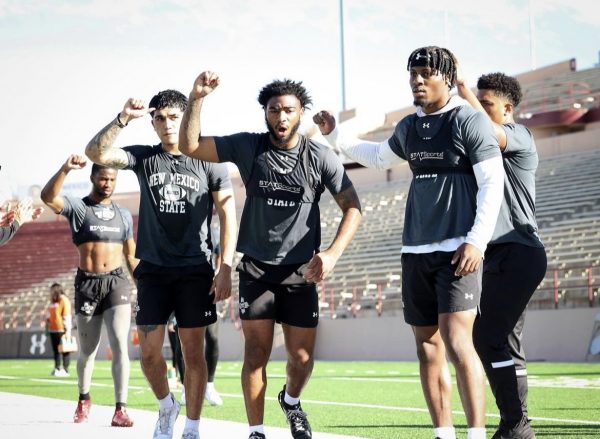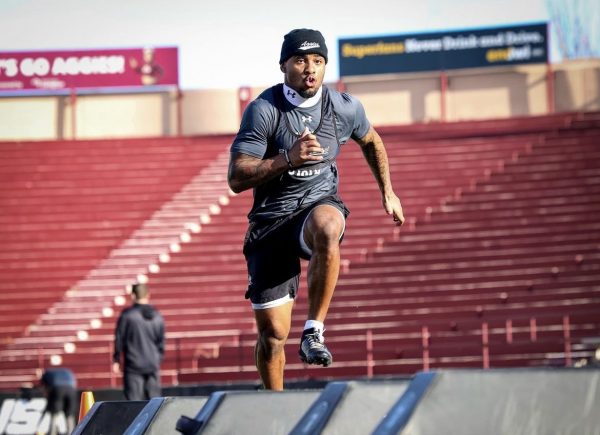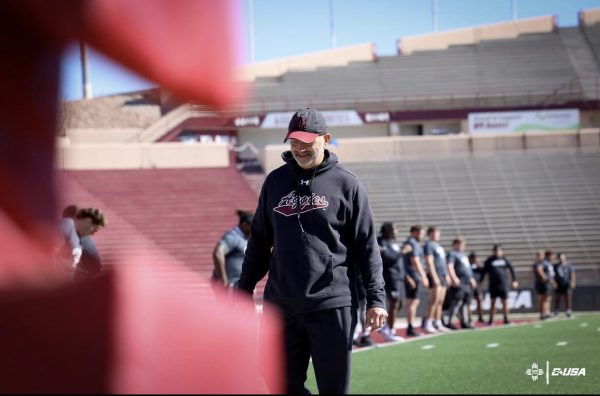
28 Mar New Mexico State Football’s Eric Klein: Your Best Ability Is Availability
Minnesota native Eric Klein boasts an incredibly successful career that spans multiple decades and several major collegiate sports programs.
The New Mexico State University Director of Sports Performance has a wealth of knowledge in strength and conditioning, derived from a multitude of different sports across three decades.
Before his role at New Mexico, he was Head Strength & Conditioning for Minnesota Gophers. Previous to that, he was Director of Sports Performance at Northern Illinois, where he oversaw sports performance for all 17 sports.
Last season was one of the Aggies’ most successful campaigns in decades. A first eight-win season since 1965 and a six-game winning streak – their longest since 1960 – saw the Aggies qualify for consecutive bowls. Klein will be looking to help his program to even greater heights in 2024.
Spring training is an important moment in the football calendar. In a long, ‘football-less’ stretch of the year, the period allows players to slowly improve fitness levels through practice sessions and weight training.
Klein views this as a pivotal time of the year for his athletes to push boundaries and develop their own game, while maintaining a sustainable workload.
Ahead of this key period, STATSports asked Klein how he implements the use of our athlete monitoring technology and how it can aid teams in their Spring Ball preparation.

In terms of overall athletic performance, what are you looking to achieve over a period like Spring Ball? Is there more of a focus on the weight room or are you looking to make speed gains on the field?
Spring Ball practices are an interesting part of the development of a football team. One of the main focal points of practice is to allow players who were underutilized during the Fall the ability to showcase their talents and gain experience in the offensive/defensive system.
This Spring we experienced a coaching staff change on the defensive side of the ball, so now there is an emphasis on learning the new system. I also believe it is a time to experiment with new ideas – practice formats, training strategies, etc. – because there is no game at the end of the week that you must be prepared for.
For me, the focus has always been the outcomes that take place on the practice/game field. The weight room (or strength training) plays a supportive role in those outcomes. Therefore, our focus is getting the best outcomes on the field for the athletes whether that is availability, faster game speeds, or more efficient movement, etc.
How does GPS monitoring play a role in that work developing your athletes on the field? Is it about optimizing performance, driving competition, increasing player availability, etc.?
The cliché is “the best ability is availability”. We have been successful at New Mexico State University because during the competitive season we have been able to have continuity with our personnel.
My goal is to track the metrics we feel can have the best impact on a player’s health and availability. If that is optimizing performance, then so be it. Spring affords me plenty of opportunities to look at various metrics and their impact on performance.
If you were to pick one KPI metric to focus on when analyzing GPS data what would it be, and how does this metric inform your training and recovery strategies?
I can’t say there is one metric I focus on. Because most of our units are worn by outside-the-box individuals, I like to look at the metrics that are concerned with volume of high-speed running and the metrics concerned with intensity of muscle actions.
Those metrics can quickly give me a snapshot of what a player’s practice looked like. They allow me to start a conversation with the athlete as to where we need to go for the next training session.
Recovery can then be guided towards what may be best for the athlete; nutritional, active recovery, or the passive recovery modalities in the training room.
If the data is a true outlier, I would like to bring the position coach into the conversation to better understand the nature of the practice: was there a change in the number of reps he took? Were those reps of a different nature (deep routes vs. short routes)? Did he notice anything different?

In terms of athletic development, how do you split out training strategies for the ‘fast’ guys and the ‘big’ guys?
We develop the physical attributes of our athletes at two levels. The first is their training age within the program, and the second is their proximity to the line of scrimmage.
Using training age as an entry point into our training program, strength in the foundational lifts (Power Clean/Deadlift, Front Squat, Bench) and technique in fundamental movement (jump, sprint, change of direction) are emphasized initially.
Regarding “fast” or “big” guys, their proximity to the line of scrimmage plays a key role in their development. The closer to the line of scrimmage a player is the more emphasis is put on absolute strength, accelerative strength, and strength-speed.
We use the Charlie Francis model of short-to-long with loaded and unloaded accelerations out about 30 yards. The skill players are trained with an emphasis on absolute strength, speed-strength, and starting strength.
We also use the short-to-long model with sprint distances going out to about 60 yards. A large aerobic capacity is important for both levels but is trained in different fashions so that it mimics what the athlete is expected to handle during practice.
Do you ever look at other sports, in terms of what their practitioners are doing, for inspiration or knowledge on bringing new sports science or S&C methodologies to football?
I have always looked at the sports of soccer and rugby for inspiration and insight to the data collected, training strategies, and training outcomes.
During the most recent Rugby World Cup, there was an article in the STATSports Sports Science Newsletter talking about some of the metrics the top rugby performance staff look at. This article inspired me to look at some of those metrics as well as others to give me a better picture of our performance outcomes.

Any success stories or instances where GPS monitoring data led to significant improvements in player readiness, injury prevention, or overall performance?
I believe the past two seasons at New Mexico State have been our success story.
Over the past two seasons we have gone to back-to-back bowl games (only the second time in school history) and competed in the Conference USA championship game.
All of this is due to player continuity and availability on game day. The coaching staff is receptive to adjusting practices as needed during the season to make sure readiness is at its highest come game day and the players who have high workloads during the week are instructed to use all available means of recovery to ensure they are ready come game time.
This type of cohesion between performance staff, coaching staff, and athletes allowed us to have 12 players run 21+ mph in multiple games and outscore opponents in the 2nd half of games.
A look ahead to the 2024 College Football Season
With one eye on the season ahead and the other on the welfare of players, coaches view pre-season to home in on their tactics and rehabilitate their players back to full fitness.
This is an opportune time for Klein and his team to develop strategies that will help build on previous successful season seasons with the university.
New Mexico are looking for a third bowl birth in three seasons – something that has never happened at NMSU in school history. No doubt, under Klein’s tutelage, and the use of STATSports technology, they will be well-prepared.
If you are a college or high school football coach, look no further than the industry’s leading wearable technology. Sign up for a demo here.